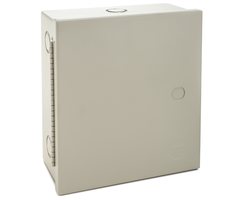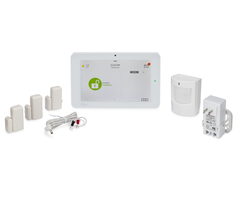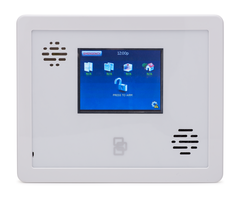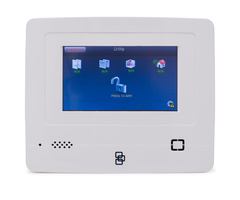How Can I Tell if My System is Wired or Wireless?
You can tell if your system is wired or wireless by checking for a few different things. If the system is self-contained and all-in-one, then it is wireless. But if the system has a metal casing and uses an external keypad, then it is hardwired. Certain keypads indicate a hardwired system.
A hardwired system cannot be controlled on its own. Instead, it is controlled using a hardwired keypad. Some users might believe that their keypad is the actual system itself. But it is important to understand that the keypad is just a controller for the system. The actual system is hidden away somewhere else in the building, often in a storage room, attic, closet or basement. The control panel for the system will usually be inside of some beige metal cabinet. If the main controller for your system has a wire leading to a beige metal cabinet, then your system is hardwired. Remember, almost every hardwired system will have some type of hardwired keypad.

But for wireless systems, the "controller" is built directly into the system. In other words, most wireless systems are all-in-one (AIO). The only wire leading from the system will likely be to a power outlet. It may also have a couple of hardwired contacts and perhaps a hardwired siren. But these add-ons are the exception to the norm for wireless systems. The big distinction is that the primary controller will not have a wire leading to a metal cabinet that contains the system. Instead, the controller is the actual system.
Wireless systems also require fewer add-ons than wired systems. With wireless systems, it is usually unnecessary to add an external keypad or a wireless receiver. But nearly every wired system will require an external keypad, as well as a wireless receiver if the user wants to use wireless sensors. And don't assume that just because your system uses wireless sensors that you have a wireless system. If a hardwired system has a wireless receiver, then wireless sensors will still be able to communicate with the system over-the-air.
Remember, a modern wired system can do almost everything a wireless system can with the proper add-ons. If a cellular communicator is added to a wired system, it will be able to communicate with an interactive service platform, like Total Connect 2.0 or Alarm.com. This will allow a user to control their system remotely through a mobile app on their Android or iOS device. Once a user has accessed the mobile app, they can arm and disarm their system, check the current status of their sensors, control any Z-Wave smart home devices (Z-Wave controller required) and more.
Did you find this answer useful?
We offer alarm monitoring as low as $10 / month
Click Here to Learn MoreRelated Products





Related Categories
- Answered



